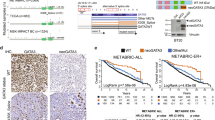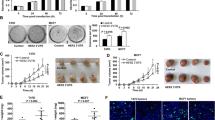Abstract
Meta-analyses of microarray data indicate that GATA3 is co-expressed with estrogen receptor alpha (ER) in breast cancer cells. While the significance of this remains unclear, it is thought that GATA3 may serve as a prognostic indicator in breast tumors and may play a role in ER signaling. Recently, reciprocal regulation of GATA3 and ER transcription was demonstrated, suggesting that control of their expression is intertwined. We sought to determine whether GATA3 and ER expression was also coordinately regulated at other levels. Unlike ER, GATA3 was not under epigenetic control and was not re-expressed in the presence of DNMT or HDAC inhibitors in ER/GATA3-negative cells. However, like ER, these inhibitors decreased GATA3 expression in ER/GATA3-positive cell lines. We have previously reported that ER mRNA stability is increased through binding of the RNA-binding protein HuR/ELAV1 to the 3′untranslated region (UTR) and that DNMT and HDAC inhibitors reduce ER expression by altering this interaction. Biotin pull-down assays using a biotinylated GATA3 RNA probe confirmed that HuR also binds to the GATA3 3′UTR. Inhibition of HuR using siRNA probes decreased GATA3 mRNA, mRNA stability and protein expression, indicating that HuR plays a role in regulating GATA3 expression. Inhibition of either HuR or GATA3 reduced cell growth of MCF7 cells. Based on our findings, it is clear that coordinate regulation of ER and GATA3 occurs, however differences do exist. These findings may aid in identification of new targets that control cell growth of breast cancer cells.






Similar content being viewed by others
Abbreviations
- AZA:
-
5-aza 2′ Deoxycytidine
- DNMT:
-
DNA methyltransferase
- ER:
-
Estrogen receptor
- HDAC:
-
Histone deacetylase
- TSA:
-
Trichostatin A
- WT:
-
Wild type
References
Mehra R, Varambally S, Ding L, Shen R, Sabel M, Ghosh D, Chinnaiyan A (2005) Kleer C: identification of GATA3 as a breast cancer prognostic marker by global gene expression meta-analysis. Cancer Res 65:11259–11264
Ciocca V, Daskalakis C, Ciocca RM, Ruiz-Orrico A, Palazzo JP (2009) The significance of GATA3 expression in breast cancer: a 10-year follow-up study. Hum Pathol 40(4):489–495
Bertucci F, Houlgatte R, Benziane A, Granjeaud S, Adelaide J, Tagett R, Loriod B, Jacquemier J, Veins P, Jordan B et al (2000) Gene expression profiling of primary breast carcinomas using arrays of candidate genes. Hum Mol Genet 9(20):2981–2991
Hoch R, Thompson D, Baker R, Weigel R (1999) GATA-3 expression is association with estrogen receptor in breast cancer. Int J of Cancer 84:122–128
Shen D, Chang H, Chen Z, He J, Lonsberry V, Elshimali Y, Chia D, Seligson S, Goodglick L, Nelson S et al (2005) Loss of annexin A1 expression in human breast cancer detected by multiple high-throughput analyses. Biochem Biophys Res Commun 326:218–227
Usary J, Llaca V, Karaca G, Presswala S, Karaca M, He X, Langerod A, Karesen R, Oh D, Dressler L et al (2004) Mutation of GATA3 in human breast tumors. Oncogene 23:7669–7678
Wilson B, Giguere V (2008) Meta-analysis of human cancer microarrays reveals GATA3 is integral to the estrogen receptor alpha pathway. Mol Cancer 7(1):49
Asselin-Labat M-L, Sutherland K, Barker H, Thomas R, Shackleton M, Forrest N, Hartley L, Robb L, Grosveld F, van der Wees J et al (2007) Gata-3 is an essential regulator of mammary-gland morphogenesis and luminal-cell differentiation. Nat Cell Biol 9:201–209
Kouros-Mehr H, Bechis S, Slorach E, Littlepage L, Egeblad M, Ewald A, Pai S, Ho I, Werb Z (2008) GATA-3 links tumor differentiation and dissemination in a luminal breast cancer model. Cancer Cell 13:141–152
Kouros-Mehr H, Slorach E, Sternlicht M, Werb Z (2006) GATA-3 maintains the differentiation of the luminal cell fate in the mammary gland. Cell 127:1041–1055
Eeckhoute J, Keeton EK, Lupien M, Krum SA, Carroll JS, Brown M (2007) Positive cross-regulatory loop ties GATA-3 to estrogen receptor alpha expression in breast cancer. Cancer Res 67(13):6477–6483
Keen JC, Davidson NE (2003) The biology of breast carcinoma. Cancer 97(3 Suppl):825–833
Kenealy MR, Flouriot G, Pope C, Gannon F (1996) The 3′untranslated region of the human estrogen receptor gene post- transcriptionally reduces mRNA levels. Biochem Soc Trans 24(1):107S
Kenealy M-R, Flouriot G, Sonntag-Buck V, Dandekar T, Brand H, Gannon F (2000) The 3′-untranslated region of the human estrogen receptor alpha gene mediates rapid messenger ribonucleic acid turnover. Endocrinology 141(8):2805–2813
Ing NH, Massuto DA, Jaeger LA (2007) Estradiol up-regulates A+ U-rich RNA-binding factor 1 p45 binding to stabilizing regions within the 3′untranslated region of estrogen receptor alpha Mrna. J Biol Chem 283(3):1764–1772
Hostetter C, Licata LA, Witkiewicz A, Costantino C, Yeo CJ, Brody JR, Keen JC (2008) Cytoplasmic accumulation of the RNA binding protein HuR is central to tamoxifen resistance in estrogen receptor positive breast cancer cells. Cancer Biol Ther 7(9):1496–1506
Pryzbylkowski P, Obajimi O, Keen J (2008) Trichostatin A and 5 Aza-2′ deoxycytidine decrease estrogen receptor mRNA stability in ER positive MCF7 cells through modulation of HuR. Breast Cancer Res Treat 111:15–25
Yang X, Phillips DL, Ferguson AT, Nelson WG, Herman JG, Davidson NE (2001) Synergistic activation of functional estrogen receptor (ER)-α by DNA methyltransferase and histone deacetylase inhibition in human ER-α-negative breast cancer cells. Cancer Res 61:7025–7029
Sharma D, Saxena NK, Davidson NE, Vertino PM (2006) Restoration of tamoxifen sensitivity in estrogen receptor-negative breast cancer cells: tamoxifen-bound reactivated er recruits distinctive corepressor complexes. Cancer Res 66(12):6370–6378
Sharma D, Blum J, Yang X, Beaulieu N, Macleod A, Davidson NE (2005) Release of methyl CpG binding proteins and histone deacetylase 1 from the estrogen receptor alpha promoter upon reactivation in ER negative human breast cancer cells. Mol Endocrinol 19(7):1740–1751
Macaluso M, Cinti C, Russo G, Russo A, Giordano A (2003) pRb2/p130–E2F4/5-HDAC1-SUV39H1–p300 and pRb2/p130–E2F4/5-HDAC1-SUV39H1-DNMT1 multimolecular complexes mediate the transcription of estrogen receptor alpha in breast cancer. Oncogene 22:3511–3517
Macaluso M, Montanari M, Noto PB, Gregorio V, Bronner C, Giordano A (2007) Epigenetic modulation of estrogen receptor-{alpha} by pRb family proteins: a novel mechanism in breast cancer. Cancer Res 67(16):7731–7737
Adams BD, Furneaux H, White BA (2007) The micro-ribonucleic acid (miRNA) miR-206 targets the human estrogen receptor-{alpha} (ER{alpha}) and represses ER{alpha} messenger RNA and protein expression in breast cancer cell lines. Mol Endocrinol 21(5):1132–1147
Liu W–H, Yeh S–H, Lu C–C, Yu S-L, Chen H-Y, Lin C-Y, Chen D-S, Chen P-J (2009) MicroRNA-18a prevents estrogen receptor-[alpha] expression, promoting proliferation of hepatocellular carcinoma cells. Gastroenterology 136(2):683–693
Miller TE, Ghoshal K, Ramaswamy B, Roy S, Datta J, Shapiro CL, Jacob S, Majumder S (2008) MicroRNA-221/222 confers tamoxifen resistance in breast cancer by targeting p27Kip1. J Biol Chem 283(44):29897–29903
Zhao J-J, Lin J, Yang H, Kong W, He L, Ma X, Coppola D, Cheng JQ (2008) MicroRNA-221/222 negatively regulates estrogen receptor{alpha} and is associated with tamoxifen resistance in breast cancer. J Biol Chem 283(45):31079–31086
Keen JC, Sholl L, Wills-Karp M, Georas SN (2001) Preferential activation of nuclear factor of activated T cells c correlates with mouse strain susceptibility to allergic responses and Interleukin-4 gene expression. Am J Respir Cell Mol Biol 24(1):58–65
Keen JC, Yan L, Mack KM, Pettit C, Smith D, Sharma D, Davidson NE (2003) A novel histone deacetylase inhibitor, scriptaid, enhances expression of functional estrogen receptor Î ± (ER) in ER negative human breast cancer cells in combination with 5-aza 2′-deoxycytidine. Breast Cancer Res Treat 81(3):177–186
Ferguson AT, Lapidus R, Baylin S, Davidson NE (1995) Demethylation of the estrogen receptor gene in estrogen receptor-negative breast cancer cells can reactivate estrogen receptor gene expression. Cancer Res 55:2279–2283
Ferguson AT, Vertino P, Spitzner J, Baylin S, Muller M, Davidson NE (1997) Role of estrogen receptor gene demethylation and DNA methyltransferase-DNA adduct formation in 5-aza-2′-deoxycytidine-induced cytotoxicity in human breast cancer cells. J Biol Chem 272(51):32260–32266
Yan L, Nass SJ, Smith D, Nelson WG, Herman JG, Davidson NE (2003) Specific inhibition of DNMT1 by antisense oligonucleotides induces re-expression of estrogen receptor a (ER) in ER-negative human breast cancer cell lines. Cancer Biol Ther 2(5):552–556
Yang X, Ferguson AT, Nass SJ, Phillips DL, Butash KA, Wang SM, Herman JG, Davidson NE (2000) Transcriptional activation of estrogen receptor α in human breast cancer cells by histone deacetylase inhibition. Cancer Res 60(24):6890–6894
Li L-C, Dahiya R (2002) MethPrimer: designing primers for methylation PCRs. Bioinformatics 18(11):1427–1431
Hinman M, Lou H (2008) Diverse molecular functions of Hu proteins. Cell Mol Life Sci 65(20):3168–3181
Acknowledgments
The authors would like to thank Dr. Cristiana Stellato for her discussions with this project.
Author information
Authors and Affiliations
Corresponding author
Additional information
The authors Lauren A. Licata and Christine L. Hostetter are equally contributed to this work.
Rights and permissions
About this article
Cite this article
Licata, L.A., Hostetter, C.L., Crismale, J. et al. The RNA-binding protein HuR regulates GATA3 mRNA stability in human breast cancer cell lines. Breast Cancer Res Treat 122, 55–63 (2010). https://doi.org/10.1007/s10549-009-0517-8
Received:
Accepted:
Published:
Issue Date:
DOI: https://doi.org/10.1007/s10549-009-0517-8




